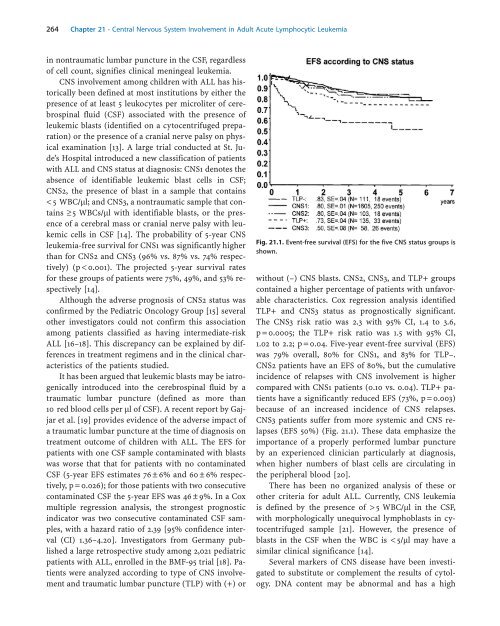Acute Leukemias - Republican Scientific Medical Library
Acute Leukemias - Republican Scientific Medical Library
Acute Leukemias - Republican Scientific Medical Library
You also want an ePaper? Increase the reach of your titles
YUMPU automatically turns print PDFs into web optimized ePapers that Google loves.
264 Chapter 21 · Central Nervous System Involvement in Adult <strong>Acute</strong> Lymphocytic Leukemia<br />
in nontraumatic lumbar puncture in the CSF, regardless<br />
of cell count, signifies clinical meningeal leukemia.<br />
CNS involvement among children with ALL has historically<br />
been defined at most institutions by either the<br />
presence of at least 5 leukocytes per microliter of cerebrospinal<br />
fluid (CSF) associated with the presence of<br />
leukemic blasts (identified on a cytocentrifuged preparation)<br />
or the presence of a cranial nerve palsy on physical<br />
examination [13]. A large trial conducted at St. Jude’s<br />
Hospital introduced a new classification of patients<br />
with ALL and CNS status at diagnosis: CNS1 denotes the<br />
absence of identifiable leukemic blast cells in CSF;<br />
CNS2, the presence of blast in a sample that contains<br />
< 5 WBC/ll; and CNS3, a nontraumatic sample that contains<br />
³5 WBCs/ll with identifiable blasts, or the presence<br />
of a cerebral mass or cranial nerve palsy with leukemic<br />
cells in CSF [14]. The probability of 5-year CNS<br />
leukemia-free survival for CNS1 was significantly higher<br />
than for CNS2 and CNS3 (96% vs. 87% vs. 74% respectively)<br />
(p < 0.001). The projected 5-year survival rates<br />
for these groups of patients were 75%, 49%, and 53% respectively<br />
[14].<br />
Although the adverse prognosis of CNS2 status was<br />
confirmed by the Pediatric Oncology Group [15] several<br />
other investigators could not confirm this association<br />
among patients classified as having intermediate-risk<br />
ALL [16–18]. This discrepancy can be explained by differences<br />
in treatment regimens and in the clinical characteristics<br />
of the patients studied.<br />
It has been argued that leukemic blasts may be iatrogenically<br />
introduced into the cerebrospinal fluid by a<br />
traumatic lumbar puncture (defined as more than<br />
10 red blood cells per ll of CSF). A recent report by Gajjar<br />
et al. [19] provides evidence of the adverse impact of<br />
a traumatic lumbar puncture at the time of diagnosis on<br />
treatment outcome of children with ALL. The EFS for<br />
patients with one CSF sample contaminated with blasts<br />
was worse that that for patients with no contaminated<br />
CSF (5-year EFS estimates 76±6% and 60±6% respectively,<br />
p=0.026); for those patients with two consecutive<br />
contaminated CSF the 5-year EFS was 46±9%. In a Cox<br />
multiple regression analysis, the strongest prognostic<br />
indicator was two consecutive contaminated CSF samples,<br />
with a hazard ratio of 2.39 [95% confidence interval<br />
(CI) 1.36–4.20]. Investigators from Germany published<br />
a large retrospective study among 2,021 pediatric<br />
patients with ALL, enrolled in the BMF-95 trial [18]. Patients<br />
were analyzed according to type of CNS involvement<br />
and traumatic lumbar puncture (TLP) with (+) or<br />
Fig. 21.1. Event-free survival (EFS) for the five CNS status groups is<br />
shown.<br />
without (–) CNS blasts. CNS2, CNS3, and TLP+ groups<br />
contained a higher percentage of patients with unfavorable<br />
characteristics. Cox regression analysis identified<br />
TLP+ and CNS3 status as prognostically significant.<br />
The CNS3 risk ratio was 2.3 with 95% CI, 1.4 to 3.6,<br />
p=0.0005; the TLP+ risk ratio was 1.5 with 95% CI,<br />
1.02 to 2.2; p=0.04. Five-year event-free survival (EFS)<br />
was 79% overall, 80% for CNS1, and 83% for TLP–.<br />
CNS2 patients have an EFS of 80%, but the cumulative<br />
incidence of relapses with CNS involvement is higher<br />
compared with CNS1 patients (0.10 vs. 0.04). TLP+ patients<br />
have a significantly reduced EFS (73%, p=0.003)<br />
because of an increased incidence of CNS relapses.<br />
CNS3 patients suffer from more systemic and CNS relapses<br />
(EFS 50%) (Fig. 21.1). These data emphasize the<br />
importance of a properly performed lumbar puncture<br />
by an experienced clinician particularly at diagnosis,<br />
when higher numbers of blast cells are circulating in<br />
the peripheral blood [20].<br />
There has been no organized analysis of these or<br />
other criteria for adult ALL. Currently, CNS leukemia<br />
is defined by the presence of > 5 WBC/ll in the CSF,<br />
with morphologically unequivocal lymphoblasts in cytocentrifuged<br />
sample [21]. However, the presence of<br />
blasts in the CSF when the WBC is < 5/ll may have a<br />
similar clinical significance [14].<br />
Several markers of CNS disease have been investigated<br />
to substitute or complement the results of cytology.<br />
DNA content may be abnormal and has a high
















